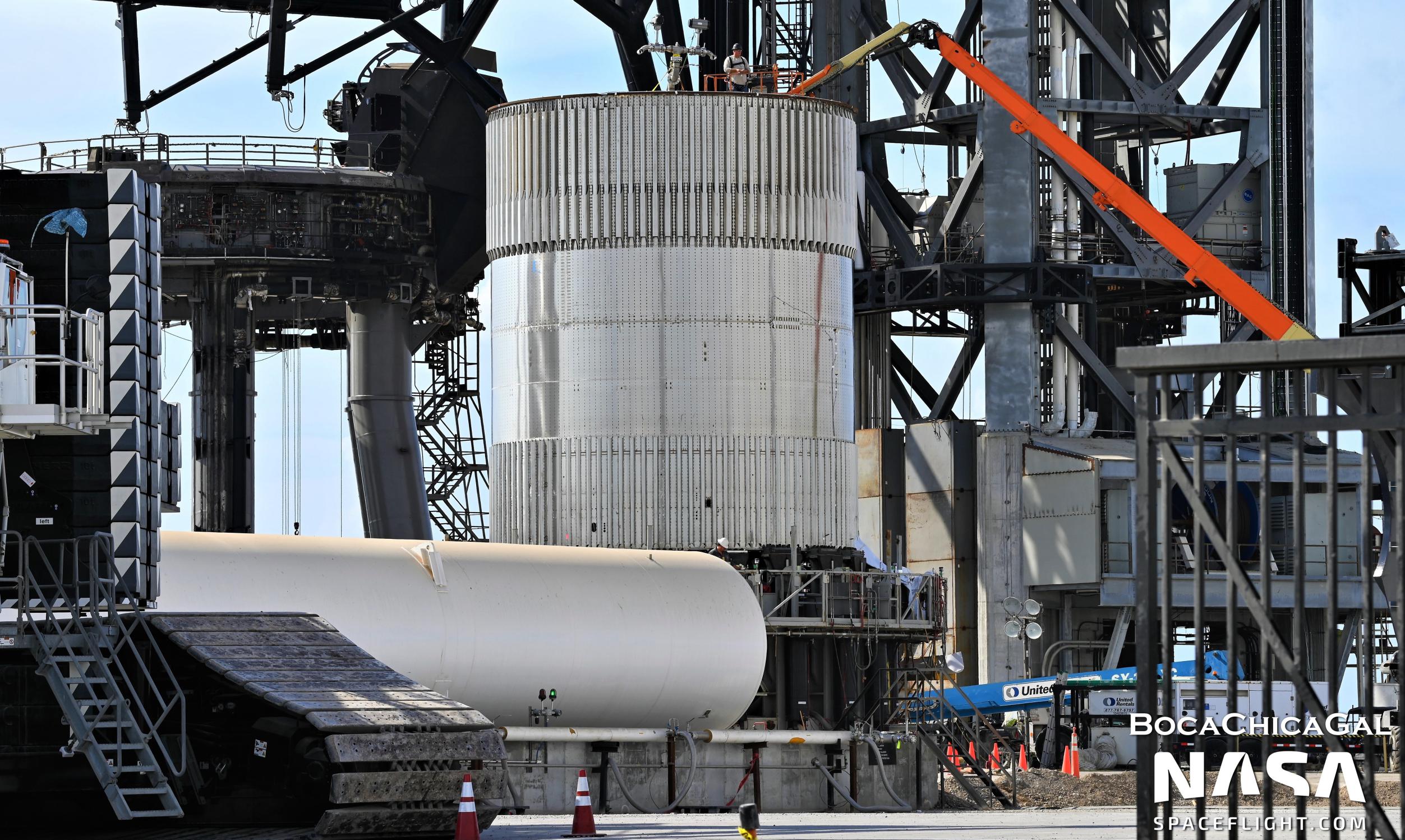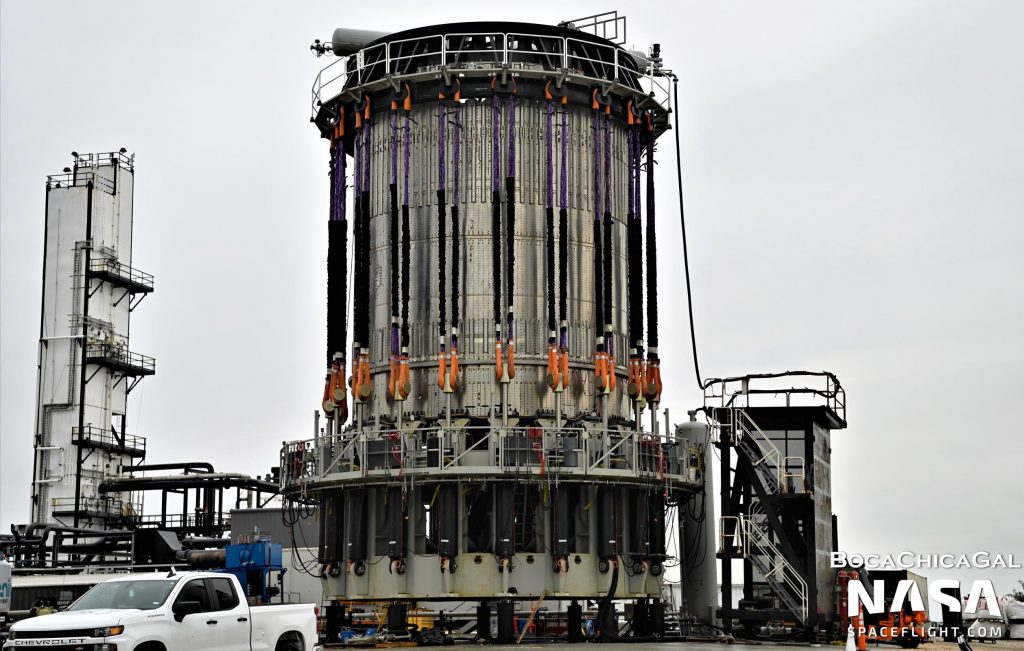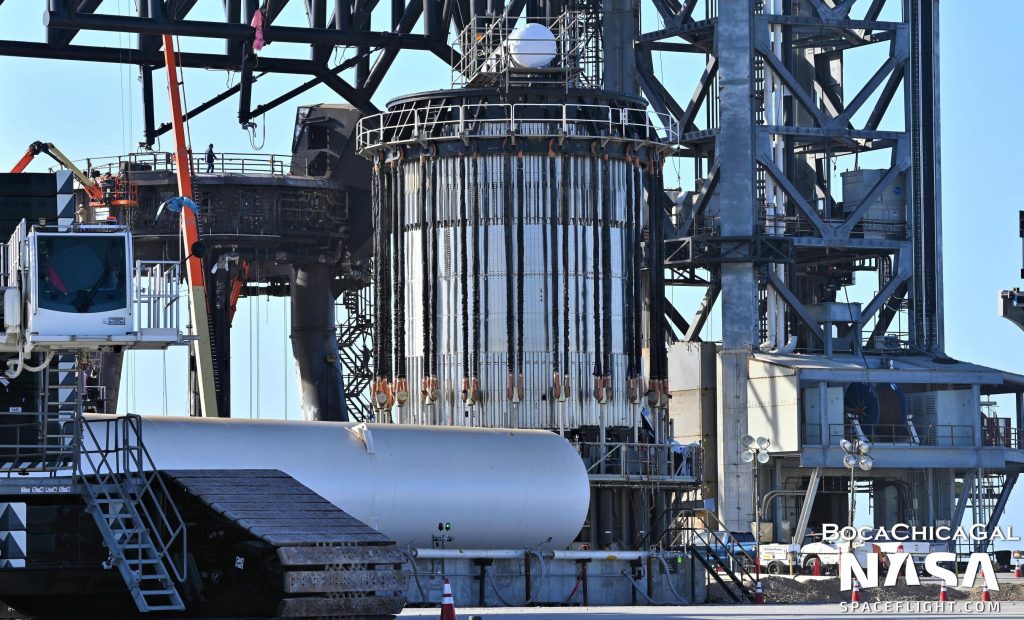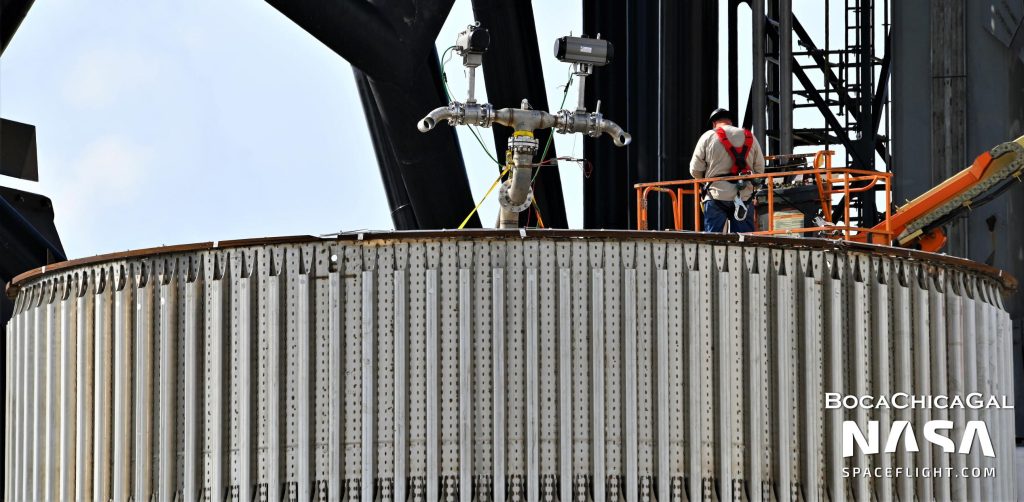

News
SpaceX Super Heavy tank prototype survives crush testing
A tank prototype similar to SpaceX’s next-generation Super Heavy rocket booster has survived a series of tests that repeatedly attempted to destroy it.
Known as Booster 7.1 or B7.1, the tank is the latest in a long line of ‘test tanks’ designed to verify the performance of Starship and Super Heavy and qualify new designs and manufacturing techniques without risking an entire upper stage or booster. In general, that means that test tanks are as minimal as possible and much shorter than either Starship stage, but they’re also assembled out of nine-meter-wide (30 ft) steel barrels and domes almost identical to the sections that make up Starship and Super Heavy.
For most of the duration of SpaceX’s steel Starship program, ‘test tank’ work has followed a fairly consistent and linear development path, where tanks were used to verify design changes before those changes were implemented on more expensive prototypes. B7.1 firmly ignored that norm.
While it’s not an exact match, the tank – built out of two stacked rings and dome sections and measuring about 11 meters (~36 ft) tall – has a Super Heavy thrust structure (where Raptor engines would attach) and external stiffeners known as stringers that are (mostly) exclusive to Starship boosters.
As its name suggests, B7.1 shares many of the significant design changes that SpaceX had already implemented on Super Heavy Booster 7 (B7). The company began testing B7 months before B7.1, subjecting the full-size booster to multiple cryogenic proof tests and Raptor thrust simulation testing to qualify its new thrust ‘puck’ and several other structural changes. SpaceX began testing B7.1 in late June, shortly before Super Heavy Booster 7 was damaged by an unplanned explosion that halted its first Raptor engine test campaign. B7.1 testing then restarted in mid-July and was completed by the end of the month.
For unknown reasons, SpaceX’s decision to build and test Booster 7 before B7.1 meant that any significant issues discovered during subsequent B7.1 testing could disqualify the booster for flight testing, potentially wasting the months of work and tens of millions of dollars already invested in the prototype. Ultimately, though, B7.1 appeared to sail through multiple cryogenic proofs and crush tests without any catastrophic issues. Only on the last crush test did any part of the test tank finally give way, and the resulting damage was minor.


B7.1’s testing made use of a relatively new two-piece stand. The tank was first installed on a sturdy base using clamps similar to those on the Starbase orbital launch site’s (OLS) launch mount. Then, a hat-like structure was placed on top of the tank, resting on the surface that a Starship upper stage would sit on during launch. Massive ropes were finally dropped down to attach to hydraulic cylinders on the base. Once B7.1 was loaded with benign cryogenic liquid nitrogen (LN2), replicating most of the thermal and mechanical stresses of real oxygen/methane propellant, the hydraulic cylinders retracted, pulling the cap down to evenly exert massive crushing forces down the vertical axis of the test tank. Simultaneously, additional rams installed underneath B7.1 may have simulated the thrust of 13 central Raptor engines.
It’s unclear what exactly SpaceX was testing. The goal of the test could have been as simple as verifying that Super Heavy Booster 7 can withstand the weight of a fully-fueled Starship (~1350 tons / ~3M lb) sitting on top of it. It could have also been used to simulate an entire orbital launch from Super Heavy’s perspective, replicating many of the forces Starship boosters will experience between liftoff and landing. Given that Booster 7’s upgraded thrust puck had already made it through stress testing, B7.1 didn’t have much to add there, but it may have been useful for estimating the compressive strength of the current Super Heavy booster design.
Regardless of what B7.1 did or didn’t prove, it did so with very little drama. After four long days of testing, at least two of which involved attempting to crush the tank, the only truly noteworthy visual event was evidence of a slight buckle near the top of the tank during its last crush test. A few days later, with the test stand ‘cap’ removed, B7.1 survived one final test in which SpaceX likely attempted to pressurize the tank until it burst. Instead, the tank didn’t so much as develop a leak, reiterating – contrary to their occasional tin-can-like appearances – just how sturdy Starship and Super Heavy really are.

With nothing more to give, SpaceX will likely scrap B7.1. Meanwhile, Super Heavy Booster 7 remains stuck inside one of SpaceX’s Starbase assembly bays after being forced back to the factory by unintentionally explosive testing. The fate of that booster is unclear but SpaceX has removed all or most of its 33 Raptor engines over the last few weeks while simultaneously expediting work on Booster 8, which may ultimately take B7’s place.
News
SpaceX’s Crew-11 mission targets July 31 launch amid tight ISS schedule
The flight will lift off from Launch Complex 39A at Kennedy Space Center in Florida.

NASA and SpaceX are targeting July 31 for the launch of Crew-11, the next crewed mission to the International Space Station (ISS). The flight will lift off from Launch Complex 39A at Kennedy Space Center in Florida, using the Crew Dragon Endeavour and a Falcon 9 booster.
Crew Dragon Endeavour returns
Crew-11 will be the sixth flight for Endeavour, making it SpaceX’s most experienced crew vehicle to date. According to SpaceX’s director of Dragon mission management, Sarah Walker, Endeavour has already carried 18 astronauts representing eight countries since its first mission with NASA’s Bob Behnken and Doug Hurley in 2020, as noted in an MSN report.
“This Dragon spacecraft has successfully flown 18 crew members representing eight countries to space already, starting with (NASA astronauts) Bob (Behnken) and Doug (Hurley) in 2020, when it returned human spaceflight capabilities to the United States for the first time since the shuttle retired in July of 2011,” Walker said.
For this mission, Endeavour will debut SpaceX’s upgraded drogue 3.1 parachutes, designed to further enhance reentry safety. The parachutes are part of SpaceX’s ongoing improvements to its human-rated spacecraft, and Crew-11 will serve as their first operational test.
The Falcon 9 booster supporting this launch is core B1094, which has launched in two previous Starlink missions, as well as the private Ax-4 mission on June 25, as noted in a Space.com report.
The four-members of Crew-11 are NASA astronauts Zena Cardman and Mike Fincke, as well as Japan’s Kimiya Yui and Russia’s Oleg Platonov.
Tight launch timing
Crew-11 is slated to arrive at the ISS just as NASA coordinates a sequence of missions, including the departure of Crew-10 and the arrival of SpaceX’s CRS-33 mission. NASA’s Bill Spetch emphasized the need for careful planning amid limited launch resources, noting the importance of maintaining station altitude and resupply cadence.
“Providing multiple methods for us to maintain the station altitude is critically important as we continue to operate and get the most use out of our limited launch resources that we do have. We’re really looking forward to demonstrating that capability with (CRS-33) showing up after we get through the Crew-11 and Crew-10 handover,” Spetch stated.
Lifestyle
EV fans urge Tesla to acquire Unplugged Performance for edge in fleet and security industry
Unplugged Performance has built a name for itself by producing performance upgrades for Tesla vehicles.

A growing number of Tesla enthusiasts and longtime community voices are calling on the electric vehicle maker to acquire Unplugged Performance, a California-based aftermarket company best known for tuning Tesla vehicles and developing specialized government fleet solutions under its UP.FIT division.
The idea was once considered a niche proposal among EV fans, but it is now gaining serious attention not just as a performance play but as a strategic move to deepen Tesla’s roots in the fleet and security industry.
A strategic fit
Unplugged Performance has built a name for itself by producing performance upgrades for Tesla vehicles, from track-optimized components to visual and aerodynamic upgrades. But in recent years, its UP.FIT division has pivoted toward a more functional future by outfitting Tesla vehicles like Model Ys for police, military, and government use.
That work has sparked growing calls for closer collaboration with Tesla, especially as the EV maker increasingly leans into autonomy, AI, and fleet services as core components of its next chapter.
“I posted this four years ago, but I think it’s more true now than ever,” wrote Whole Mars Catalog, a well-known Tesla investor and FSD Beta tester, on X. “Tesla should buy Unplugged. But not just as a Performance division. What they are doing with UP.FIT unlocks large government and commercial fleet purchases that can improve utilization.”
Tesla fans such as shareholder Sawyer Merritt echoed the sentiment, calling Unplugged a “great fit within Tesla.” adding, “They are literally located directly next to Tesla’s design studio in Hawthorne.”
Enabling the next wave
Supporters of the idea noted that integrating Unplugged into Tesla’s corporate structure could help accelerate the adoption of autonomous technologies in government sectors. With UP.FIT patrol cars already in use across some U.S. police departments, Tesla fans envisioned a future where self-driving Teslas could potentially revolutionize law enforcement, search-and-rescue, and public service logistics.
“Just imagine how autonomous patrol cars could transform policing and bring us into a safer future,” the veteran FSD tester wrote.
The benefits could also extend to Tesla’s existing consumer base. “They also have some incredible products in the works that I think will appeal to many ordinary Tesla drivers — not just those looking for performance or mods. Stuff that’s so good it should have come straight from the design studio next door,” Whole Mars Catalog noted.
Unplugged Performance, founded in 2013, shares not just a product vision with Tesla, but also geography. Its Hawthorne headquarters sits directly adjacent to Tesla’s design studio, and the two companies have maintained a close working relationship over the years. The aftermarket firm has long positioned itself as a “mission-aligned” partner to Tesla.
In response to the recent calls for acquisition, Unplugged Performance acknowledged the support from the community. “Our very existence is to support the Tesla mission with @UpfitTesla and @UnpluggedTesla,” Unplugged CEO Ben Schaffer posted on X. “We love working with Tesla and are grateful for the community’s support since 2013!”
News
Tesla debuts hands-free Grok AI with update 2025.26: What you need to know
All new Tesla vehicles delivered on or after July 12, 2025, will include Grok AI out of the box

Tesla has begun rolling out Grok, an in-car conversational AI assistant developed by xAI, to eligible vehicles starting July 12. The feature marks the most direct integration yet between Elon Musk’s artificial intelligence startup and Tesla’s consumer product lineup, offering drivers hands-free access to a chat-style companion while on the road.
Grok comes pre-installed on new vehicles
According to Tesla’s FAQ page for the feature, all new vehicles delivered on or after July 12, 2025, will include Grok AI out of the box. Owners of older vehicles may gain access through an over-the-air update, provided their vehicle meets a few hardware and software requirements.
Specifically, Grok is currently only supported on Tesla models equipped with an AMD infotainment processor and running vehicle software version 2025.26 and higher. Compatible models include the Model S, Model 3, Model X, Model Y, and Cybertruck. A Premium Connectivity subscription or active Wi-Fi connection is also required.
Tesla notes that additional vehicle compatibility may arrive in future software updates.
Grok’s features and limitations for now
Drivers can engage with Grok using the App Launcher or by pressing and holding the voice command button on the steering wheel. Grok is designed to answer questions and hold conversations using natural language, offering responses tailored to its chosen personality—ranging from “Storyteller” to the more eccentric “Unhinged.”
For fun, Tesla posted a demonstration of Grok likely running on “Unhinged” talking about what it would do to Optimus when they are on a date, much to the shock of the humanoid robot’s official social media account.
It should be noted, however, that Grok cannot currently issue commands to the vehicle itself, at least for now. Traditional voice commands for tasks like climate control, navigation, or media remain separate from Grok as of writing.
The feature is being released in Beta and does not require a Grok account or xAI subscription to activate, although that policy may change over time.
Grok privacy and in-car experience
Tesla emphasizes that interactions with Grok are securely processed by xAI and not linked to a user’s Tesla account or vehicle. Conversations remain anonymous unless a user signs into Grok separately to sync their history across devices.
Tesla has also begun promoting Grok directly on its official vehicle webpages, showcasing the feature as part of its in-car experience, further highlighting the company’s increasing focus on AI and infotainment features on its all-electric vehicles.
-

 Elon Musk2 weeks ago
Elon Musk2 weeks agoTesla investors will be shocked by Jim Cramer’s latest assessment
-

 Elon Musk3 days ago
Elon Musk3 days agoxAI launches Grok 4 with new $300/month SuperGrok Heavy subscription
-

 Elon Musk5 days ago
Elon Musk5 days agoElon Musk confirms Grok 4 launch on July 9 with livestream event
-

 News1 week ago
News1 week agoTesla Model 3 ranks as the safest new car in Europe for 2025, per Euro NCAP tests
-

 Elon Musk1 week ago
Elon Musk1 week agoxAI’s Memphis data center receives air permit despite community criticism
-

 News2 weeks ago
News2 weeks agoXiaomi CEO congratulates Tesla on first FSD delivery: “We have to continue learning!”
-

 Elon Musk2 weeks ago
Elon Musk2 weeks agoTesla scrambles after Musk sidekick exit, CEO takes over sales
-

 News2 weeks ago
News2 weeks agoTesla sees explosive sales growth in UK, Spain, and Netherlands in June
















